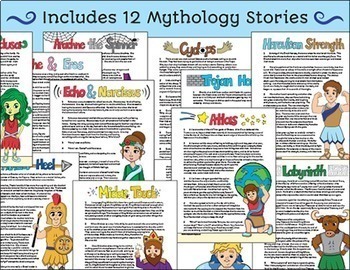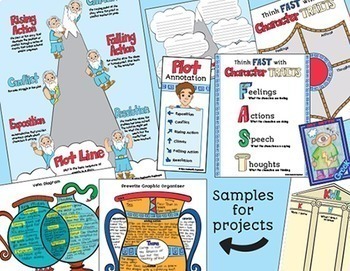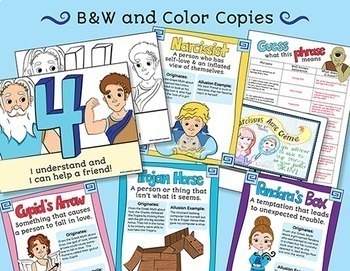Greek Mythology Unit - Stories - Activities - Allusions - Story Elements
- Zip
What educators are saying
Products in this Bundle (4)
Description
Greek Mythology Unit that includes Twelve Greek Mythology Stories integrated with ELA skills of Story Elements and Allusions. Literacy skills in the bundle:
- Inferring Character Traits
- Plot Development
- Determining Theme
- Allusions
The stories and Greek mythology characters have been made age appropriate while not too childish so that upper elementary will enjoy it.
4 overarching learning goals:
• I can identify, describe, and sequence the elements of plot.
• I can identify theme by analyzing plot and characters.
• I can define and infer character traits.
• I can explain, recognize, and analyze the characteristics of allusion and determine the meaning.
15 very detailed, step by step lesson plans that include
• Enduring Understandings
• Essential Questions
• Skills/Learning Goals
• Formative Assessments
• Motivational Hooks/Anticipatory Set with engaging YouTube links.
• Learning Goal Scales and Student Tracking sheet (Marzano)
12 Greek Mythology Passages
Achilles Heel
The Trojan Horse
Psyche and Eros
Arachne the Spinner
Medusa and Perseus
Midas Touch
Pandora’s Box
Cyclops
Atlas
Labyrinth
Herculean Strength
Echo and Narcissus
11 Greek Mythology Allusion Posters and student list
• Annotation and Rubric for analyzing plot and text.
• Anchor Chart and Graphic Organizers
• TEST acronym printable for identifying theme
• FAST acronym printable for inferring character traits
• WINK acronym printable for analyzing allusion
• Pre/Post concept check on vocabulary
• Tickets out the door (exit slips)
• Foldable plotline
• Foldable to analyze allusion.
• Story Plotline graphic organizer
• Vertical plotline task
• Venn Diagram
• “Help Wanted” Ad Template with rubric
• Allusion Movie Review planning sheet, printout, rubric
• Allusion product and billboard templates and rubric
• Trading Card Planning sheet, template and rubric
• Prewriting template and Vase themed lined paper
• Completed samples of each task
Check out our other ELA Units:
Identify and Determine Literary Theme
CCSS Alignment:
4th Grade ELA - RL 4.1, 4.2, 4.3, 4.4
5th Grade ELA - RL 5.1, 5.2, 5.3, 5.4
We hope you enjoy this bundle! Thanks!
Hubbard’s Cupboard





